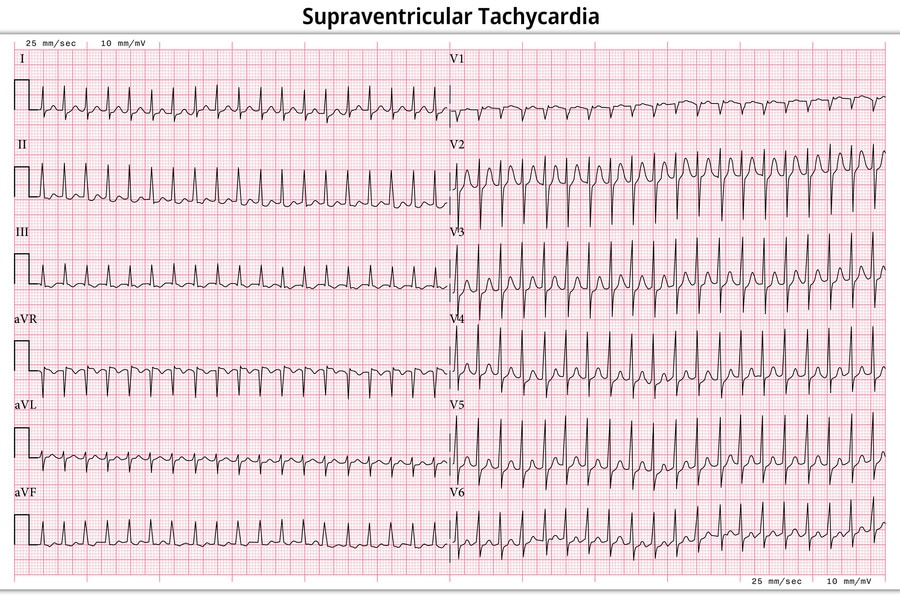Supraventricular tachycardia (SVT) is a group of heart rhythm disorders characterized by an abnormally fast heart rate that originates above the heart’s ventricles. The term “supraventricular” means above the ventricles, referring to the atria and atrioventricular (AV) node, the heart’s electrical system’s upper parts.
Overview:
SVT can occur in healthy individuals, and episodes may last a few minutes to several hours. In some cases, SVT may not cause any significant health issues, but prolonged episodes or frequent recurrence can lead to complications. It’s essential to understand the different types of SVT, the symptoms associated with this condition, and the available treatment options.
Symptoms:
The symptoms of SVT can vary depending on the individual, the type of SVT, and the duration of the episode. Common symptoms include:
- Palpitations (feeling of rapid, fluttering, or pounding heartbeats)
- Lightheadedness or dizziness
- Shortness of breath
- Chest pain or discomfort
- Fainting (syncope)
- Fatigue or weakness
- Anxiety
Causes:
SVT occurs due to abnormal electrical pathways in the heart, which can result in a rapid heart rate. The specific cause may vary depending on the type of SVT. Some common causes include:
- Abnormal electrical connections in the heart present at birth (congenital)
- Problems with the AV node
- Heart disease or structural abnormalities
- Certain medications
- Stimulants such as caffeine, tobacco, or alcohol
- Emotional stress or physical exertion
Risk Factors:
Some factors that may increase the risk of developing SVT include:
- Age (SVT can occur at any age, but some types are more common in young people)
- Gender (females are more likely to experience SVT)
- Family history of heart rhythm disorders
- Congenital heart disease or structural abnormalities
- High blood pressure
- Thyroid problems
- Diabetes
- Obesity
Prevention:
To reduce the risk of SVT or prevent recurrence, consider the following:
- Maintain a healthy weight and exercise regularly.
- Limit caffeine and alcohol intake.
- Manage stress through relaxation techniques, meditation, or yoga.
- Quit smoking.
- Get regular check-ups and manage existing health conditions like high blood pressure or diabetes.
- Follow your healthcare provider’s recommendations regarding medications and lifestyle changes.
When to See the Doctor:
If you experience recurrent or persistent symptoms of SVT, seek medical attention. It’s essential to determine the specific type of SVT and develop an appropriate treatment plan to manage the condition and prevent complications.
Additional Information:
Treatment options for SVT may include medications, lifestyle changes, or procedures such as catheter ablation. In some cases, a combination of these approaches may be necessary. Your healthcare provider will work with you to develop a tailored treatment plan based on the type of SVT, your symptoms, and your overall health.
Types of SVT:
There are several types of SVT, including atrial fibrillation, atrial flutter, paroxysmal supraventricular tachycardia (PSVT), and Wolff-Parkinson-White (WPW) syndrome. Each type has its characteristics and may require different treatment approaches.
Vagal maneuvers:
Certain physical maneuvers can stimulate the vagus nerve, which may help slow down the heart rate during an SVT episode. These maneuvers include coughing, holding your breath, and bearing down (Valsalva maneuver), or immersing your face in cold water (diving reflex). However, these techniques should be performed only under the guidance of a healthcare professional.
Electrocardiogram (ECG):
An ECG is a vital diagnostic tool for SVT. It records the electrical activity of the heart and can help identify the specific type of SVT and guide treatment decisions.
Electrophysiology (EP) study:
In some cases, an EP study may be recommended to pinpoint the precise location of the abnormal electrical pathway causing SVT. This invasive procedure involves inserting catheters into the heart to map its electrical activity.
Impact on Quality of Life:
Although SVT is not always life-threatening, it can significantly affect an individual’s quality of life. Frequent or prolonged episodes can cause discomfort, anxiety, and fatigue, making it challenging to perform daily activities or enjoy leisure time.
Prognosis:
Most people with SVT can lead healthy lives with appropriate treatment and lifestyle changes. However, the prognosis may vary depending on the type of SVT, the presence of other health conditions, and the individual’s response to treatment.
Importance of Follow-Up:
Regular follow-up appointments with a healthcare provider are crucial for managing SVT effectively. These appointments allow for monitoring of the condition, adjusting treatment plans, and addressing any concerns or questions.
In conclusion, Supraventricular tachycardia is a group of heart rhythm disorders characterized by a rapid heart rate originating above the heart’s ventricles. Although SVT may not always cause serious health issues, it’s essential to understand the condition, recognize the symptoms, and seek appropriate medical care. By managing risk factors and following your healthcare provider’s recommendations, you can effectively manage SVT and maintain a healthy heart.









